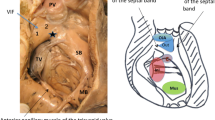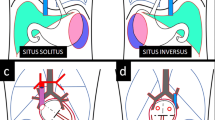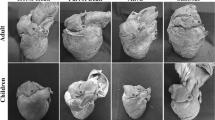Abstract
Symmetry of bronchi, lung lobation, and atrial appendages is frequently found in patients with heterotaxy syndromes. To evaluate the reliability of thoracic situs as an indicator of atrial appendage morphology, thoracic situs was assessed in 306 postmortem cases: 250 with atrial situs solitus and 56 with heterotaxy syndromes. Five features that indicate thoracic situs were assessed: (1) lung lobation, (2) lengths of main bronchi, (3) ratio of left to right (L/R) bronchial lengths, (4) relationship of bronchi to ipsilateral pulmonary artery, and (5) number of cartilage rings in each main bronchus. In the group with heterotaxy, the expected symmetrical lung lobation, lengths of bronchi, number of cartilage rings, and relations to pulmonary arteries were found in 77, 77, 77, and 95% of cases, respectively. The ratios of L/R bronchial lengths were ≤1.5 in 90% of cases. The relations of the bronchi to the pulmonary arteries were the best predictors of symmetrical atrial appendages or splenic syndromes. Bronchial–atrial discordance occurred in ten cases: in situs solitus in one case and in heterotaxy in nine cases. Detection of heterotaxy syndromes is important because of the associated severe congenital cardiac defects. No single feature of thoracic situs is completely reliable. All available data should be used to make the diagnosis.



Similar content being viewed by others
References
Anderson C, Devine WA, Anderson RH, Debich DE, Zuberbuhler JR (1990) Abnormalities of the spleen in relation to congenital malformations of the heart: a survey of necropsy findings in children. Br Heart J 63:122–128
Brandt PWT, Calder AL (1977) Cardiac connections: the segmental approach to radiologic diagnosis in congenital heart disease. Curr Probl Diagn Radiol 7:1–35
Brandt HM, Liebow AA (1958) Right pulmonary isomerism associated with venous, splenic, and other anomalies. Lab Invest 7:469–504
Calder AL (1990) Morphological features in situs ambiguus. In: Crupi G, Parenzan L, Anderson RH (eds) Perspectives in pediatric cardiac surgery. Futura Publishing Company, Mount Kisco, NY, pp 273–277
Caruso G, Becker AE (1979) How to determine atrial situs? Considerations initiated by 3 cases of absent spleen with a discordant anatomy between bronchi and atria. Br Heart J 41:559–567
Clarkson PM, Brandt PW, Barratt-Boyes BG, Neutze JM (1972) “Isolated atrial inversion”. Visceral situs solitus, viscero atrial discordance, discordant ventricular d loop without transposition, dextrocardia: diagnosis and surgical correction. Am J Cardiol 29:877–881
Cohen SR, Landing BH (1976) Tracheostenosis and bronchial abnormalities associated with pulmonary artery sling. Ann Otol Rhinol Laryngol 85:582–590
Deanfield JE, Leanage R, Stroobant J, Chrispin AR, Taylor JF, Macartney FJ (1980) Use of high kilo voltage filtered beam radiographs for detection of bronchial situs in infants and young children. Br Heart J 44:577–583
Debich DE, Devine WA, Anderson RH (1990) Polysplenia with normally structured hearts. Am J Cardiol 65:1274–1275
Devine WA, Debich DE, Taylor SR (1988) Symmetrical bronchial pattern with normal atrial morphology. Int J Cardiol 20:395–398
Epstein ML, Formanek AG, Bessinger FB, Edwards JE (1980) Situs inversus with complete transposition. Am Heart J 99:510–516
Evans WN (2010) Thoracoabdominal situs: a practical approach accompanied by a short history of descriptive terms. Pediatr Cardiol 31:1049–1051
Freedom RM, Fellows KE Jr (1973) Radiographic visceral patterns in the asplenia syndrome. Radiology 107:387–391
Freedom RM, Harrington DP (1974) Anatomically corrected malposition of the great arteries. Report of 2 cases, one with congenital asplenia; frequent association with juxtaposition of atrial appendages. Br Heart J 36:207–215
Freedom RM, Culham G, Rowe RD (1978) The criss-cross and superoinferior ventricular heart: an angiocardiographic study. Am J Cardiol 42:620–628
Gerlis LM, Dura-Vila G, Ho SY (2000) Isomeric arrangement of the left atrial appendages and visceral heterotaxy: two atypical cases. Cardiol Young 10:140–144
Jewell F, Joffe H, Wilde P (1993) Isomerism of the left atrial appendages associated with bronchoatrial discordance and unusual systemic venous drainage. Cardiol Young 3:225–228
Landay MJ, Chaw C, Bordlee RP (1982) Bilateral left lungs: unusual variation of hilar anatomy. AJR Am J Roentgenol 138:1162–1164
Landing BH, Lawrence TY, Payne VC Jr, Wells TR (1971) Bronchial anatomy in syndromes with abnormal visceral situs, abnormal spleen and congenital heart disease. Am J Cardiol 28:456–462
Liberthson RR, Hastreiter AR, Sinha SN, Bharati S, Novak GM, Lev M (1973) Levocardia with visceral heterotaxy-isolated levocardia: pathologic anatomy and its clinical implications. Am Heart J 85:40–54
Moller JH, Nakib A, Anderson RC, Edwards JE (1967) Congenital cardiac disease associated with polysplenia. A developmental complex of bilateral “left-sidedness”. Circulation 36:789–799
Partridge JB, Scott O, Deverall PB, Macartney FJ (1975) Visualization and measurement of the main bronchi by tomography as an objective indicator of thoracic situs in congenital heart disease. Circulation 51:188–196
Peoples WM, Moller JH, Edwards JE (1983) Polysplenia: a review of 146 cases. Pediatr Cardiol 4:129–137
Phoon CK, Neill CA (1994) Asplenia syndrome: Insight into embryology through an analysis of cardiac and extracardiac anomalies. Am J Cardiol 73:581–587
Pipitone S, Calcaterra G, Grillo R, Thiene G, Sperandeo V (1985) Broncho-atrial discordance. A clinically diagnosed case. Int J Cardiol 9:374–378
Prendiville TW, Barton LL, Thompson WR, Fink DL, Holmes KW (2010) Heterotaxy syndrome: defining contemporary disease trends. Pediatr Cardiol 31:1052–1058
Raman R, Al Ali SY, Poole CA, Dawson BV, Carman JB, Calder L (2003) Isomerism of the right atrial appendages: clinical, anatomical, and microscopic study of a long-surviving case with asplenia and ciliary abnormalities. Clin Anat 16:269–276
Rose V, Izukawa T, Moes CA (1975) Syndromes of asplenia and polysplenia. A review of cardiac and non-cardiac malformations in 60 cases with special reference to diagnosis and prognosis. Br Heart J 37:840–852
Sapire DW, Ho SY, Anderson RH, Rigby ML (1986) Diagnosis and significance of atrial isomerism. Am J Cardiol 58:342–346
Stanger P, Rudolph AM, Edwards JE (1977) Cardiac malpositions: an overview based on study of sixty-five necropsy specimens. Circulation 56:159–172
Tunaoglu FS, Olgunturk R, Gucuyener K, Demirsoy S, Uzamis C (1991) Unusual variation of asplenia syndrome. Jpn Heart J 32:859–865
Uemura H, Ho SY, Devine WA, Anderson RH (1995) Analysis of visceral heterotaxy according to splenic status, appendage morphology, or both. Am J Cardiol 76:846–849
Van Mierop LH, Wiglesworth FW (1962) Isomerism of the cardiac atria in the asplenia syndrome. Lab Invest 11:1303–1315
Van Mierop LH, Eisen S, Schiebler GL (1970) The radiographic appearance of the tracheobronchial tree as an indicator of visceral situs. Am J Cardiol 26:432–435
Van Praagh R (1972) The segmental approach to diagnosis in congenital heart disease. Birth Defects (Original Article Series) 8:4–23
Van Praagh S, Kreuzer J, Alday L, Van Praagh R (1990) Systemic and pulmonary venous connections in visceral heterotaxy, with emphasis on the diagnosis of the atrial situs: A study of 109 post mortem cases. In: Clark E, Takao A (eds) Developmental cardiology: morphogenesis and function. Futura Publishing Company, Mount Kisco, NY, pp 671–721
Winer-Muram HT, Tonkin IL (1989) The spectrum of heterotaxic syndromes. Radiol Clin North Am 27:1147–1170
Winer-Muram H, Ellis JV, Scott RL, Pinstein ML (1985) Isolated left thoracic isomerism. Radiology 155:10
Author information
Authors and Affiliations
Corresponding author
Rights and permissions
About this article
Cite this article
Louise Calder, A. Thoracic Situs As an Indicator of Atrial Appendage Morphology: A Postmortem Study of 306 Specimens With Situs Solitus in 250 and Heterotaxy in 56 Cases. Pediatr Cardiol 32, 875–884 (2011). https://doi.org/10.1007/s00246-011-0003-z
Received:
Accepted:
Published:
Issue Date:
DOI: https://doi.org/10.1007/s00246-011-0003-z




